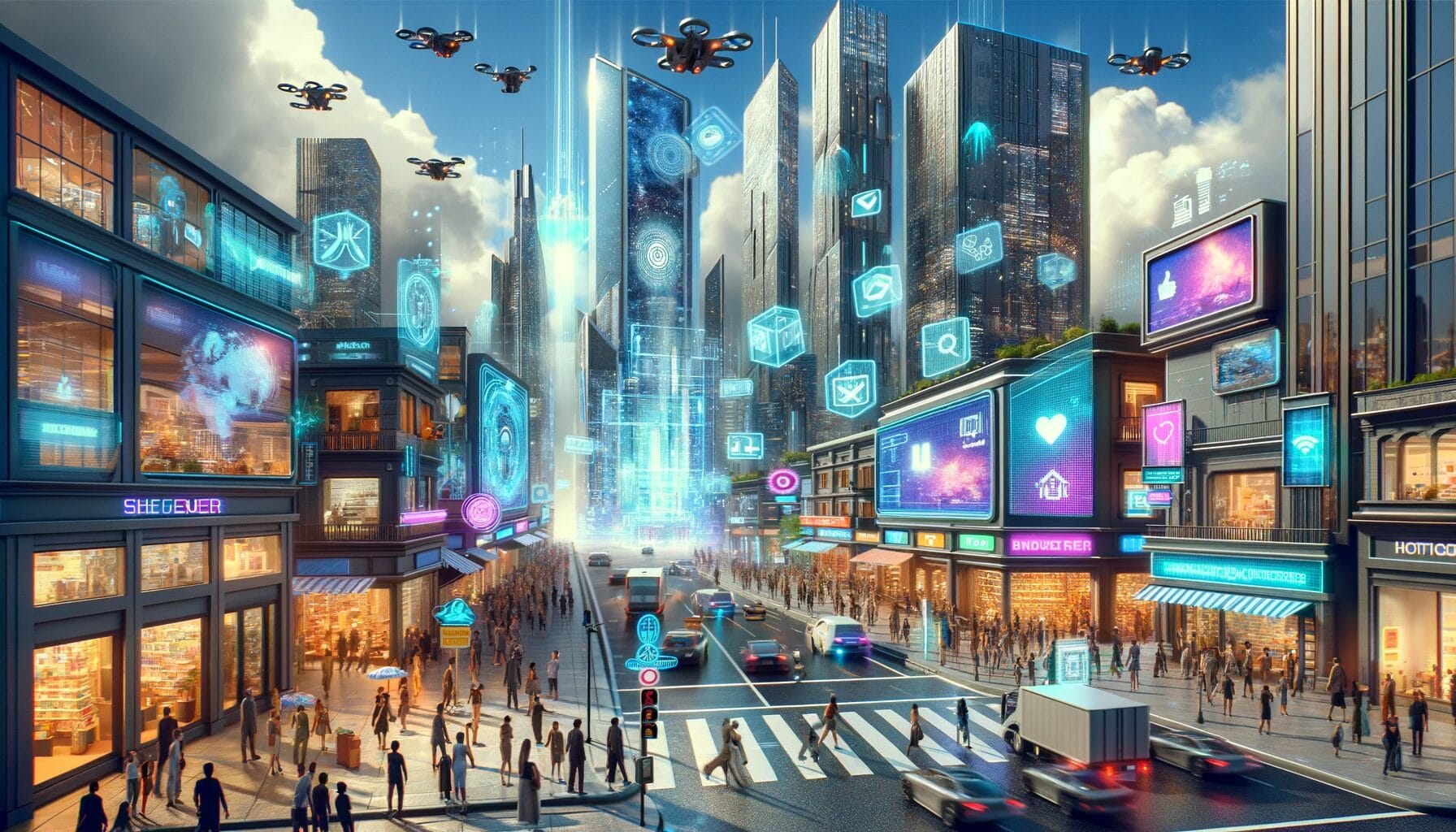Is 100% digital retail possible in the future?

Photo credits : image created with Dall-E
While the physical store remains an essential destination for customers, the continuing development of digital technology and the ever-increasing digitalisation of society could end up changing all that, giving rise to a new model of retail that is entirely online. Could tomorrow’s retail be exclusively digital?
Just imagine… The year is 2050. 6G has replaced 5G, giving access to an incredibly fast, swift and powerful Internet. Thanks to nanotechnology and the quantum revolution, computers have acquired a computing power that was unimaginable at the beginning of the century, reaching several billion operations per second, enabling terminals to process colossal volumes of information far more than in the past.
The IoT has networked the entire world, connecting every object to the internet, everywhere, in public and private spaces, in the city and the countryside, digitalising every square centimetre. Society as a whole has become an IT superstructure that runs on data all the time, relying on algorithms to optimise every single process.
Any product can now be sold online, including the most complex, the heaviest, the largest and the most unexpected – food, cars, clothes, houses – and then 3D printed by customers from anywhere, individually or in batches, much faster and must more accurately. In just a few decades, additive manufacturing has made spectacular progress and become an industry standard accessible to all.
Over the years, e-commerce has undergone exponential, irresistible, meteoric growth, gaining market share like a gigantic tidal wave, conquering more and more customers, in more and more sectors, before becoming a dominant and inescapable modus operandi of consumer habits.
Physical stores have been losing momentum for a number of years, and have finally disappeared. The closure of the last of these stores only gave rise to a subtle homage, barely a few lines posted in digital media, which went almost unnoticed. This event was long overdue. Halfway through the 21st century, retail had moved to an exclusively digital model, operating solely online, with no real-world presence. Platforms have supplanted stores.
At a time when digital is playing an increasingly important role in customers’ lives, could this scenario be possible in the future? What trends and innovations suggest that such a development, representing a radical shift in the history of retail, might one day be possible?
Data, the keystone of a new retail.
The main characteristic of the digital world, and definitely the most unique, is that every action taken online, even the most minute, such as a simple click or the pressure of a finger on a keyboard, automatically produces information. This is the first time in history that a technology has been able to do this. This is why, since the beginning of the 21st century, for businesses and individuals alike, data has become the vector of a system of production and consumption centred on information, with the prospect of harnessing it at even higher levels of efficiency. In turn, this is what has gradually led to the radical transformation of society through digitalisation, which influences how we communicate, work, discover new products and take advantage of new services. Everything that made up the way organisations operated in the past has been reformed by digital technology. All the benchmarks that enabled them to reorientate their business models, increase their profits, get to know their customers and plan their strategies have ended up becoming dependant on data, entirely designed, organised and structured around it.
This obviously applies to the retail sector, which has taken full advantage of this new paradigm. Data has enabled us to reinvent the way we sell, the way we approach customers, the way we think about our offers, the way we add value to products, and also the way we manage logistics and stocks. Now that data is everywhere in businesses, and the focus is no longer on integrating it but on exploiting it, it is giving rise to a new form of retail that is set to revolutionise e-commerce.
The era of DNVB.
Digital Native Vertical Brands (DNVBs) are brands that have been dealing with consumers for the last ten years or so. These brands have been created and operate exclusively online, with no middleman, no physical sales outlets and in direct contact with customers, following in the footsteps of Amazon’s successful formula. This is the pure player concept at its peak.
There are currently 715 DNVBs in France, compared to just 344 in 2019, according to the DNVB 2023 Barometer published by the Payplug platform in collaboration with Digital Native Group. Their average turnover in France in 2022 was €5.48 million, up 19% from the previous year. A substantial growth rate. According to Vincent Redrado, CEO of the Digital Native Group: “DNVBs have been able to identify new consumer needs and offer a quick solution. They are therefore brands that innovate, not on a product category but on the offer linked to this category. They are redefining the rules.”
This phenomenon is booming on a global scale. It has to be said that the innovative and totally disruptive “direct to consumer” model of these new brands fits in perfectly with the current rules of the game and those of the digital economy. Operating solely online enables them to reduce costs, with lower operating expenses and therefore increased margins, but also to have a differentiated product offer, establish a closer link with customers and thus guarantee a better understanding of their expectations while at the same time attracting greater community engagement, to place customer service at the heart of the reactor, to provide a high value-added service and to better master the various communication channels, notably social networks. Bolstered by these many advantages, DNVBs have ended up colonising all sectors. In France, Spring offers home delivered laundry, Bergamote does the same with flowers, Slip Français with underwear, Baya with yoga equipment, French Bandit with pet accessories, 900.care with beauty products, JNPR with non-alcoholic drinks, etc. Services that would have been inconceivable just two or three years ago.
While some of these disruptive young start-ups, whether in France or elsewhere, are opting for omnichannel solutions by opening one or more physical points of sale, most remain 100% online. In doing so, they are encouraging the rise of a model that is naturally adapted to the advancement and increasing complexity of digital technology, and more likely to appeal to the younger generation.
The influence of Gen Alpha.
While Gen Zers, born between 1997 and 2010, are seen by traditional brands as the customers of the future, as the ones you need to target, the ones you need to win over, Generation Alpha is destined to follow in their footsteps. These are the new “digital natives”, even more connected than their predecessors, and even more familiar with digital tools. The young people of this generation were not born with digital technology but literally within it, surrounded by screens, smartphones, consoles and tablets, with several easily accessible social networks, the emergence of virtual reality and the IoT, in a society shaped by AI and algorithms.
In 2023, a survey carried out by the GECE Research and Statistics Institute revealed that 96% of children were connected to screens from the age of 6 and were becoming more mature in their use of digital tools from the age of 9. According to Catherine Thévenot, a Researcher in Cognitive Development at Lausanne University: “Today, 60% of children learn to use a smartphone between the ages of 4 and 6. This is knowledge acquired well before they reach adulthood, and ahead of what they will learn at school.” Alphas are the hyper-connected generation, as their relationship with the world and others is shaped by digital technology.
They truly are the customers of tomorrow. In around ten years’ time, they will be avid consumers of products available online, constantly on the lookout for new platforms, and their smartphones will be the preferred tool for making purchases. In their eyes, e-commerce will always be more intuitive and more advantageous than physical retail. By the same token, they will be at the forefront of companies, pushing innovation forward, looking for the best strategy to sell products and services to their peers, who are also hyper-connected, who also come from a generation for whom digital technology is the vector of their relationship with others, and this at a time when their action levers have been highly digitised.
For all these reasons, in a world that is becoming increasingly digital and organised around data, and in a context of significant growth in the digital economy and constant improvement in platforms, applications and terminals, it would be tempting to think that retail could one day detach itself from all its physical ties.
However, we can be sure that, as dematerialisation gains ground, the need to re-establish retail as a human relationship, defined by people and places, will also grow in response. The physical store, which has always adapted, is far from going extinct and there is little chance that we’ll see its disappearance within this century.

